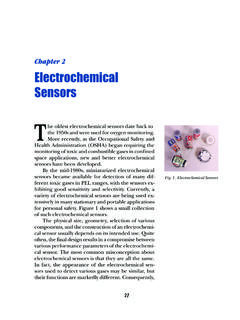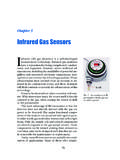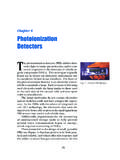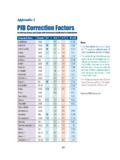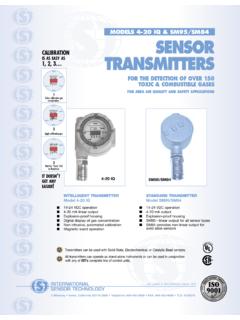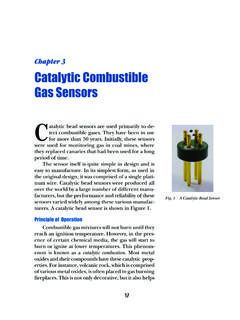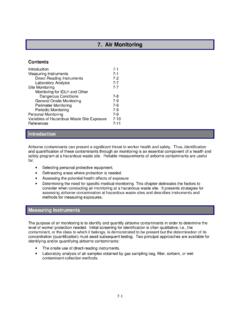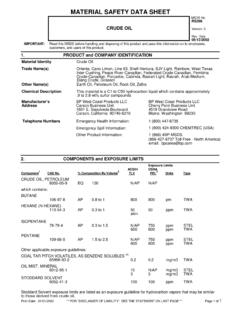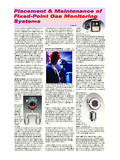Transcription of Solid-State Gas Sensors - International Sensor Technology
1 47 Chapter 4 Solid-State Gas SensorsChapter 4 Solid-State Gas SensorsWhen scientists were doing research work re-lated to semiconductor p-n junctions,1 theydiscovered that these junctions were sensitiveto environmental background that time, such a behavior was considered aproblem. This problem, however, was solved by en-capsulating the semiconductor chip so that it was nolonger exposed to the outside environment. Subse-quently, unsuccessful attempts were made to utilizethe sensitivity of the semiconductor junction as a gasdetection wasn t until 1968 that Mr. N. Taguchi marketeda simple semiconductor, or a Solid-State Sensor , for thedetection of hydrocarbons in LEL combustible intention was to provide an alternative to thepopular catalytic bead Sensor , which suffered fromseveral problems, including loss of sensitivity with timedue to poisoning and burning out when exposed tohigh gas 1972, International Sensor Technology (IST) inIrvine, California introduced a Solid-State Sensor forthe detection of hydrogen sulfide in a range of 0-10ppm.
2 A few years later, IST developed Solid-State sen-sors for the detection of more than 100 different haz-ardous gases at low ppm levels. This was a significantdevelopment, since OSHA was being formed at about1 The positive and negative junctionsin a 1 A Solid-State sensorused for detecting more than ahundred toxic Gas Monitorsthe same time and began to regulate acceptable gasconcentration levels for safety at the , Solid-State Sensors are available for the de-tection of more than 150 different gases, includingsensors for the gases which could otherwise only bedetected using expensive analytical are now several manufacturers of solid -statesensors, but each Sensor has different characteristicsand different manufacturers offer different levels ofperformance and manufactured, Solid-State Sensors offer avery long life expectancy.
3 It is not unusual to find fullyfunctional Sensors that were installed 30 years Rise in Popular Use of Solid-State Sensors . Inthe early 1980s, Japan passed a law that required gasdetectors to be installed in residential apartmentswhere gas bottles were being used. For this huge mar-ket, the competition was between Solid-State and cata-lytic bead there were some initial complaints aboutsolid-state Sensors that produced false alarms, this wasfar outweighed by the long life the Sensor catalytic Sensors burn the gas being detected, Sensor material is consumed and changed in the pro-cess and the Sensor eventually burns Solid-State Sensors , on the other hand, gassimply adsorbs onto the Sensor surface, changingthe resistance of the Sensor material. When the gasdisappears, the Sensor returns to its original condi-tion.
4 No Sensor material is consumed in the process,and hence the Solid-State Sensors offer a long life a few years of usage, the catalytic Sensors hadbecome less popular for such applications due to theneed for frequent Sensor of OperationA Solid-State Sensor consists of one or more metal49 Chapter 4 Solid-State Gas Sensorsoxides from the transition metals, such as tin oxide,aluminum oxide, etc. These metal oxides are preparedand processed into a paste which is used to form abead-type Sensor . Alternatively, thick or thin film-chipsensors are made when the metal oxides are vacuumdeposited onto a silica chip, in a fashion similar tomaking heating element is used to regulate the sen-sor temperature, since the finished Sensors exhibitdifferent gas response characteristics at differenttemperature ranges. This heating element can be aplatinum or platinum alloy wire, a resistive metaloxide, or a thin layer of deposited platinum.
5 Thesensor is then processed at a specific high tempera-ture which determines the specific characteristicsof the finished the presence of gas, the metal oxide causes thegas to dissociate into charged ions or complexeswhich results in the transfer of electrons. The built-in heater, which heats the metal oxide material to anoperational temperature range that is optimal for thegas to be detected, is regulated and controlled by aspecific pair of biased electrodes are imbedded into themetal oxide to measure its conductivity change. Thechanges in the conductivity of the Sensor resultingfrom the interaction with the gas mol-ecules is measured as a signal. Typically,a Solid-State Sensor produces a verystrong signal, especially at high gas are different ways of makingsolid-state Sensors , each arrangementmaking the Sensor s performancecharacteristics different.
6 Two typicalstyles are the following:1. Bead-type Sensor (Figure 2)2. Chip-type Sensor (Figure 3, next page)CollectorHeaterControlVOUTP latinumCoil HeaterFig. 2. Schematic Diagram of a Bead-type Sensor50 Hazardous Gas MonitorsMost Solid-State Sensors have threeor four pins, depending on how theheater and bias electrodes are Sensors are among themost versatile of all Sensors , as they de-tect a wide variety of gases, and can beused in many different applications. Dif-ferent response characteristics are achieved by vary-ing the semiconductor materials, processing tech-niques, and Sensor operating the unique attributes of the Solid-State sen-sor are the abilities of the Sensor to detect both lowppm levels of gases, as well as high combustible The main strength of the solid -statesensor is its long life expectancy, as the Sensor typi-cally lasts 10 years or more in clean applications.
7 Thisis a major advantage compared to other Sensor types,such as catalytic bead or electrochemical Sensors ,which typically last only one to two , while Solid-State Sensors have a longerlife expectancy, they are also more susceptible to in-terference gases than the other types of Sensors . Thus,in applications where other background gases arepresent, Solid-State Sensors may trigger false certain instances, the interferences from othergases are minimized by using appropriate filtering ma-terials that absorb all other gases except the gas to example, a Solid-State Sensor for monitoringcarbon monoxide and hydrogen can be equipped witha charcoal filter which eliminates the majority of in-terfering gases. This way the Sensor performs very welland becomes very selective for those two The versatility of the Solid-State sensorFig. 3 Chip-type SensorHeater ResistorSilicon SubstrateTerminationTerminationCollector 51 Chapter 4 Solid-State Gas Sensorsis one of its main advantages.
8 For example, in chemi-cal plants, a gas monitoring system may involve themonitoring of many different gases and ranges, oreven the same gas with multiple , the lower ranges need to be monitored forcertain gases for toxic concentrations while simulta-neously, the same gas needs to be monitored in thecombustible range for explosive Solid-State Sensor is capable of detecting gasin both ranges. This greatly simplifies the system de-sign and maintenance required because it eliminatesor minimizes the use of multiple Sensor technologieswhich must be designed and maintained list of gases that are detectable by using IST ssolid-state Sensors is shown in Table 1 (pages 52-53).The typical ppm ranges which are chosen arethree to five times the permissible exposure limitsfor an eight-hour work day or ranges that can bebased on the sensitivity as well as the interferencecharacteristic of the Sensor , whichever is the mostpractical in an Specificationsfor Solid-State Sensors *Accuracy: 3% to 10% of full scaleResponse Time: T80 ranges from 20seconds to 90 secondsTemperature Range: 20oC to +50oCHumidity: 5 9%Life Expectancy: 10+ yearsPower Consumption: Approx.
9 300mW*Actual specifications will vary depending ongas and Gas MonitorsAcetic Acid100 -Acetone100yesAcetonitrile100 -Acetylene50yesAcrolein(Acrylaldehyde)50 -Acrylic Acid100 -Acrylonitrile50yesAllyl Alcohol -yesAllyl Chloride200 -Ammoniax50yesAnisole100 -Arsenic Pentafluoride5 -Arsine1 -Benzene50yesBophenyl50yesBoron Trichloride500 -Boron Triflluoride500 -Bromine20 -Butadiene50yesButane400yesButanol1000ye sButene -yesButyl Acetate100yesCarbon Disulfide50 -Carbon Monoxide50yesCarbon Tetrachloride50 -Cellosolve acetate100 -Chlorine10 -Chlorine Dioxide10 -Chlorobutadiene -yesChloroethanol200 -Chloroform50 -Chlorotrifluoroethylene -yesCumene -yesCyanogen Chloride20 -Cychlohexane100yesCyclopentane50 -Table 1: IST s Solid-State Sensors Gas ListGAS FULL-SCALE RANGELow ppm LELor higherGAS FULL-SCALE RANGELow ppm LELor higherDeuteriumyesDiborane10 -Dibromoethane50 -Dibutylamine -yesDichloroethane (EDC)50yesDichlorofluoroethane100 -Dichloropentadiene50 -Dichlorosilane50 -Diesel Fuel50yesDiethyl Benzene -yesDiethyl Sulfide10 -Difluorochloroethane -yesDifluoroethane (152A) -yesDimethyl Ether -yesDimethylamine (DMA)20 -Epichlorohydrin50 -Ethane1000 -Ethanol200yesEthyl Acetate200yesEthyl Benzene200yesEthyl Chloride100yesEthyl Ether100yesEthylene100yesEthylene Oxide5yesFluorine20 -Formaldehyde15 -Freon-111000 -Freon-12100 -Freon-22100 -Freon-113100 -Freon-1141000 -Freon-1231000 Fuel Oil or Kerosene -yesGasoline100yesGermane10 -Heptane1000yesHexane50yes53 Chapter 4 Solid-State Gas SensorsTable 1 (continued).
10 IST s Solid-State Sensors Gas ListGAS FULL-SCALE RANGELow ppm LELor higherGAS FULL-SCALE RANGELow ppm LELor higherHexane100yesHydrazine5 -Hydrogen50yesHydrogen Bromide50 -Hydrogen Chloride50 -Hydrogen Cyanide20 -Hydrogen Fluoride20 -Hydrogen Sulfide5yesIsobutane1000yesIsobutylene -yesIsopentane1000 -Isoprene -yesIsopropanol200yesJP41000yesJP51000ye sMethane100yesMethanol200yesMethyl Acetate30 -Methyl Acrylate60 -Methyl Bromide20 -Methyl Butanol -yesMethyl Cellosolve -yesMethyl Chloride100yesMethyl Ethyl Ketone100yesMethyl Hydrazine5 -Methyl Isobutyl Ketone200yesMethyl Mercaptan30 -Methyl Methacrylate100yesMethyl-Tert Butyl Ether -yesMethylene Chloride20yesMineral Spirits200yesMonochlorobenzene -yesMonoethylamine30 -Morpholine500 -Naptha1000yesNatural Gas1000yesNitric Oxide20 -Nitrogen Dioxide20 -Nitrogen Trifluoride50 -Nonane2000 -Pentane200yesPerchloroethylene200 -Phenol100 -Phosgene50 -Phosphine3 -Phosphorus Oxychloride200 -Picoline -yesPropane100yesPropylene100yesPropylen e Oxide100yesSilane10 -Silicon Tetrachloride1000 -Silicon Tetrafluoride1000 -Styrene200yesSulfur Dioxide50 -Tetrahydrofuran200yesTetraline100 -Toluene50yesToluene Diisocyanate15 -Trichloroethane50 -Trichloroethylene50yesTriethylamine (TEA)100 -Trifluoroethanol25 -Trimethylamine (TMA)50 -Tungsten Hexafluoride50 -Turpentine -yesVinyl Acetate1000yesVinyl Chloride20yesVinylidene Chloride50 -Xylene100.

